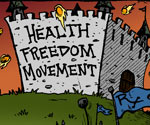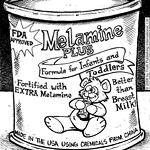Vitamin A Toxicity - Is It Possible to Get too Much Vitamin A?
| Share on Facebook | Share on Twitter | Share on Google+ |
Millions of school children growing up in the United States are taught the story of the intrepid arctic explorer Robert Peary. Although certain aspects of his story were controversial, Peary is generally credited with being the first person to reach the North Pole, riding on a sled pulled by a dog team. Peary nearly lost his team of dogs, as well as some of his own fingers, when he and the dogs ate polar bear liver.
A few years later, a Swiss scientist died when his South Pole expedition sacrificed some of its sled dogs and he ate the liver. Just 30 grams (one ounce) of polar bear or sled dog liver is enough to kill, because of the tremendous overdose of vitamin A.
Most of us, of course, don't eat polar bear livers or kill sled dogs to avoid starvation. In much of the world, getting an overdose of vitamin A is not the problem. More often, the problem is deficiency.
In much of tropical South America, almost all of Africa, Iraq, India, and the Philippines, vitamin A deficiency causing blindness and skin disorders is almost epidemic. But it is possible to overdose on vitamin A even if you are taking an over the counter supplement—and you don't know how much you really need.
The Two Common Kinds of Vitamin A and Vitamin A Toxicity
We get more than one kind of vitamin A from food. The retinoid form of vitamin A is found in liver, fish liver oil, butter, and cream. When we consume this form of vitamin A from food or supplements, it is stored in our livers until our bodies need it. The problem is, there is a limit to how much vitamin A the liver can store, and at some point vitamin A becomes toxic.
There is also a second from of vitamin A that is found in plant foods, beta-carotene. The human body stores this form of vitamin A in our fat cells, and converts into an active form of vitamin A as needed. Beta-carotene is non-toxic, but excesses of vitamin A can cause a variety of symptoms, such as:
- Reduced mineral density in bone, causing fractures and broken bones
- Liver problems
- Growth of bone spurs, painful protrusions of bone into soft tissue
- Dry skin
- Peeling skin
- Pain and inflammation at the corners of the mouth (angular cheilitis)
- High blood pressure inside the skull, which is the most common immediate cause of death when there is a severe overdose.
Vitamin A causes soft tissues and membranes to swell with fluid, which can cause them to rupture. The effect is less severe when there is no deficiency of vitamin E, calcium, zinc, or the amino acid taurine (most abundant in seafood and meat). The effect is more severe when cholesterol levels are low.
How Much Vitamin A Is Too Much?
You have to just say no to eating polar bear liver, sled dog liver, and dried walrus liver. Should you ever encounter these foods, know that they are potentially poisonous. Other foods are non-toxic with regard to vitamin A, no matter how much you eat. A safe dose of a vitamin A supplement depends on whether or not you have a vitamin A deficiency.
If you have a vitamin A dose, and you are not pregnant, then a single dose of 100,000 to 400,000 IU of vitamin A will resupply your liver and rapidly correct any deficiency symptoms. Millions of children in the developing world receive this dose of vitamin A to prevent childhood blindness. This dosage of vitamin is also used to treat measles. It is a single, one-time dose of the vitamin, not a daily supplement.
For daily supplementation, the following dosages are considered safe:
- 0–3 years: 600 µg or 2000 IU
- 4–8 years: 900 µg or 3000 IU
- 9–13 years: 1700 µg or 5665 IU
- 14–18 years: 2800 µg or 9335 IU
- 19+ years: 3000 µg or 10,000 IU
If you are a woman and there is any possibility you may be pregnant, however, be doubly sure to check the dosage of any supplement you take to prevent taking too much vitamin A causing possible harm to your unborn child. To be very sure of safety, nutritionists usually recommend limiting vitamin A to 5,000 IU per day, or, even better taking up to 25,000 IU of beta-carotene.
Selected References:
Hussey GD, Klein M (1990). A randomized, controlled trial of vitamin A in children with severe measles. N. Engl. J. Med. 323 (3): 160–4
Sarkanen JR, Nykky J, Siikanen J, Selinummi J, Ylikomi T, Jalonen TO (September 2007). Cholesterol supports the retinoic acid-induced synaptic vesicle formation in differentiating human SH-SY5Y neuroblastoma cells. Journal of Neurochemistry 102 (6): 1941–52.
-
Skin CareMen Skin Care
-
Free ResourcesFree eBooks
-
When it comes to eating right and exercising, there is no "I'll start tomorrow." Tomorrow is disease.Terri Guillemets
-
Featured Health Supplement
 ...don't believe those companies or people who say that tablets are not as bio-available. If they are designed and manufactured correctly it is possible to deliver results which are impossible to do with either liquids or capsules.
...don't believe those companies or people who say that tablets are not as bio-available. If they are designed and manufactured correctly it is possible to deliver results which are impossible to do with either liquids or capsules.
-



















